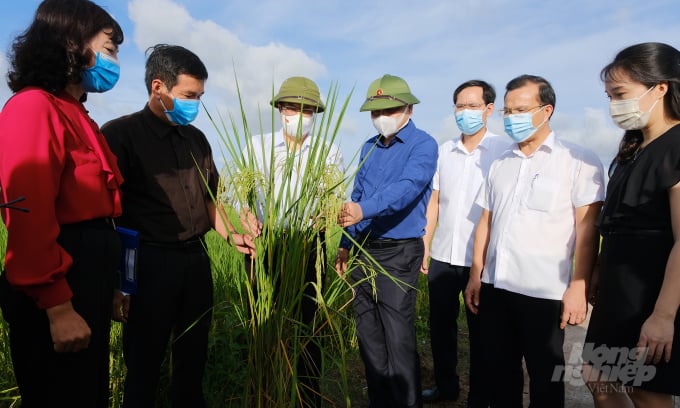November 26, 2025 | 21:51 GMT +7
November 26, 2025 | 21:51 GMT +7
Hotline: 0913.378.918
November 26, 2025 | 21:51 GMT +7
Hotline: 0913.378.918

Deputy Minister Nguyen Hoang Hiep (middle) using models of silicon nano-fertilizers in Ninh Binh. Photo: Bao Thang.
On September 22nd, the Ministry of Agriculture and Rural Development delegation, led by Deputy Minister Nguyen Hoang Hiep, visited two models of silicon nano-fertilizers use in Yen Khanh district, Ninh Binh. Observing cantaloupes grown in greenhouses and rice fields laden with cotton, disease-free, the delegation was delighted and appreciated the effectiveness of the new fertilizers generation.
Silicon nano-fertilizer based on nano application is produced by Nanofarm Company, and exclusively distributed by Dang Quang Nanofarm Company. As a fertilizer with a balanced ratio of nutrients, these fertilizer strains have been tested in a number of localities. First step brought many positive feedback.
In Ninh Binh, silicon nano-fertilizers have been used since 2020, on crops such as rice, leafy vegetables, peanuts, cucumbers, etc. As a result, the yield increased by about 30% or more. Especially on rice, the plants become hard and strong, limiting pests, diseases and reducing about 50% of the pesticides used.
Specifically, the total cost on fields using silicon nano decreased by about 4.8 million VND/ha. In which, the amount of pesticides decreased by 50%, and the amount of fertilizer decreased by 30-40%. Additionally, rice yield increased by an average of 40% compared to conventional fertilizers.
On cucumber plants, the cost is reduced by 12.5 million VND/ha. Watermelon by more than 5 million VND/ha. With vegetables, the cost savings is about 9.2 million/ha. With peanuts, farmers can cut 5.7 million VND/ha. Sweet potato by 5 million VND/ha.
With the fertilizer prices continuously increasing since the beginning of 2021, the use of fertilizers is economical and appropriate, and at the same time, researching new products similar to silicon nano-fertilizer that help ensure productivity, quality and efficiency is a potential direction.
Ms. Hoang Hai Anh, Director of Dang Quang Nanofarm Company, said that nanoscale fertilizers (under 100nm) help plants absorb easily. Currently, there are many types of silicon-containing fertilizers on the market, with different concentrations and names. Depending on the ratio of silicon and the mixing substances, fertilizers will have different effects on plants.
"The development of a new generation fertilizer product by Nanofarm Dang Quang Joint Stock Company, using silicon nanotechnology is one of the effective measures towards responsible and sustainable agriculture", Mr. Hoang Trung Director of the Department of Plant Protection commenting on new generation fertilizers.
Concluding the meeting on the afternoon of September 22nd, Deputy Minister of Agriculture and Rural Development Nguyen Hoang Hiep suggested Ninh Binh province to continue to research and replicate new technologies, avoiding dependence on traditional inorganic fertilizers. Because this is a thorough policy by the Ministry of Agriculture and Rural Development, as well as a solution to help farmers reduce input costs, increasing investment efficiency in industrial production.
"Using nanotechnology fertilizers helps to reduce costs and increase crop yields. This is the best approach to convince farmers," Deputy Minister Nguyen Hoang Hiep said.
Translated by Nguyen Hai Long

(VAN) The model of making a living under the forest canopy through the agroforestry system in Van Son commune, Bac Ninh province, is expected to generate an annual income of approximately VND 30 million/ha.

(VAN) Many enterprises in Can Tho are harnessing natural energy and reducing greenhouse gas emissions in their production processes, thereby contributing to the promotion of a sustainable green transition.
/2025/11/24/3536-2-112800_176.jpg)
(VAN) Dong Nai now has tens of thousands of hectares of forests certified for sustainable management, and this area will continue to be expanded in the coming period.

(VAN) Vinh Ha hamlet (Dai Xuyen commune, Hanoi) is shifting away from small-scale farming as households adopt bioscurity into their breeder chicken models.

(VAN) Heavy rains make aquatic species more vulnerable to disease. Proactive water management and high-tech systems help farmers prevent outbreaks and protect yields.

(VAN) Greenhouses are shifting production mindsets in Binh Lu commune, enabling farmers to ‘weather the sun and rain’ and secure stable vegetable harvests throughout the year.

(VAN) Green transition is crucial for the Mekong Delta amid climate change and stricter standards, offering a path toward sustainability.